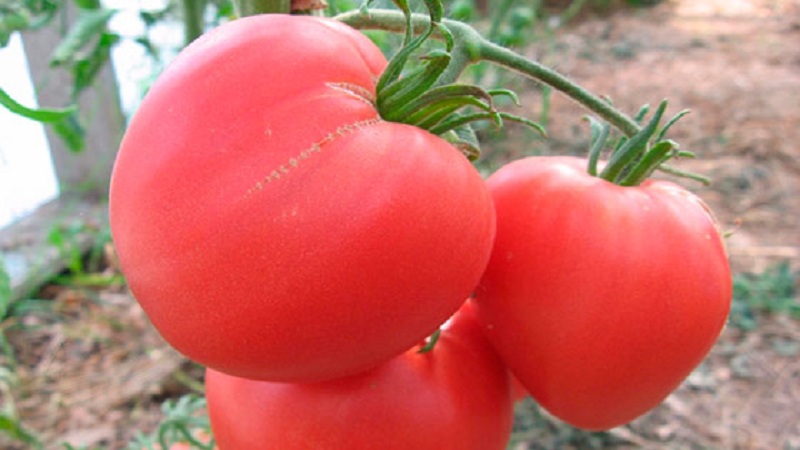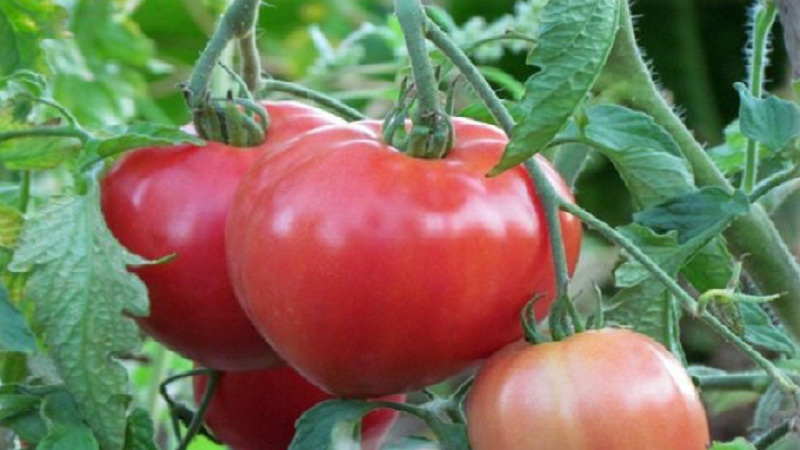Tips from experienced gardeners on growing "Pink Heart" tomato
Pink tomato varieties are popular among summer residents due to their thin skin and fleshy, sugar pulp. The absence of acid allows them to be safely consumed by people suffering from high acidity of the stomach.
This article will discuss one of these varieties - the Pink Heart tomato: its features, cultivation, protection from diseases and pests.
The content of the article
Description of the variety
Tomatoes Pink Heart were included in the State Register database in 2007. The agrofirm "Poisk" was engaged in the development. The plant belongs to indeterminate (tall) varieties, therefore it is best suited for growing in greenhouses. Landing in open ground is acceptable in regions with a warm climate.
Garter and the formation of bushes is carried out without fail. A good result is obtained when the plant is formed into one or two stems.
The photo shows the Pink Heart tomatoes.

The table below shows the characteristics of these tomatoes:
| Indicators | Characteristic |
| Weight | Fruits from the first harvest are large - 400–500 g. From the subsequent harvest, specimens of 200–230 g are collected. |
| The form | Heart-shaped, slightly ribbed. |
| Coloration | Unripe fruits are light green, ripe - pink. |
| Leaves | Large size dark green. |
| Inflorescence type | Plain. |
| Pulp | Medium density. |
| Taste qualities | The pulp is fleshy, sugary. |
| Skin | Thin, but does not crack when ripe. |
| Appointment | Suitable for making salads, tomato juice. |
| Bushes height | Reaches 2 meters. |
| Ripening period | A mid-season variety, ripens in 110–120 days. |
| Yield | Low: 6.1 kg from 1 m² or up to 3 kg from 1 bush. |
| Sustainability | To viral lesions. |
| Transportability | Poorly tolerates transportation. |
| Density of disembarkation | No more than 3 bushes per 1 m². |
Pros and cons of the variety
Among the advantages of culture are the following:
- pleasant, sweet taste;
- a small amount of acid;
- increased content of vitamins B1, B6 and C;
- non-susceptibility to viral diseases;
- stable formation of ovaries regardless of weather conditions;
- simultaneous ripening of fruits.
The disadvantages include the following points:
- impossibility of long-term storage and transportation over long distances;
- low productivity;
- large fruits do not fit in jars, so they can only be salted in a barrel, which is not suitable for everyone;
- in regions with a harsh climate, the variety is grown only in greenhouses;
- capriciousness of culture in care;
- weak stems require a garter.
How to grow
Considering the peculiarities of the cultivation of indeterminate varieties and the whimsicality of the Pink Heart tomatoes, agricultural technology should be taken seriously, especially if you are aiming at getting the maximum yield.
Seed preparation and seedling growing
Start preparing seed in early March. Pre-soak the seeds in Fitosporin solution to stimulate germination and prevent infection.
Prepare a light, loose soil and place it in the seedling container. Small plastic containers will do. Make a 1 cm depression in the ground and pour with a weak solution of potassium permanganate at room temperature. Spread the seeds 2 cm apart.Pour a layer of soil mixed with peat on top, cover with foil and place on a windowsill with sufficient light. The optimum germination temperature is + 25 ° C.
After sprouting, remove the polyethylene and remove the containers for a week in a cooler place with an air temperature of +15 ° C. Then increase it to +23 ° С.
Dive tomatoes after two true leaves appear. Prepare a substrate based on peat, sand and humus in a 1: 1: 1 ratio and add superphosphate. Transplant the seedlings into peat cups and, as they grow, into larger pots. Cover the stem with soil to strengthen the rhizome.
Stepping apply when the seedlings are 4-5 cm long. Remove excess shoots and form two stems. Complete each transplant with irrigation with a solution of alcohol or potassium permanganate.
Start hardening the sprouts daily about a week before transplanting. Leave the pots outdoors for 2-3 hours. To prevent the seedlings from stretching, observe the light and temperature conditions:
- illumination - no longer than 16 hours;
- daytime temperature - +20 ° С, at night - +10 ° С.
Advice... Remove the bottom three leaves two days before planting to prevent bacteria from getting infected.
Transfer to soil
Carry out planting in the ground 60-65 days after sowing. The seedlings should already have 8-10 leaves and one inflorescence. Treat the greenhouse with sulfur the day before to kill pests and bacteria. Moisten the seedlings abundantly.
Dig holes 20 cm deep and add 1 liter of ash, 1 liter of humus, 15 g of superphosphate. Plant the seedlings 50 cm apart and cover the ground with mulch. This will ensure proper air exchange in the rhizome, eliminate the need to loosen the soil and retain moisture. The landing pattern is staggered.
Watering
Moisten the earth in the morning, depending on the stage of plant development:
- young seedlings need frequent but moderate watering;
- an adult crop is watered abundantly, but much less frequently.
When planting seedlings, add 5 liters of warm water to the holes. Repeat watering after 10 days.
Advice... To control the moisture level, dig in a plastic bottle with an open neck near the rhizome and pour water into it. The soil will gradually moisturize.
Top dressing and care

Apply fertilizers throughout the entire period of tomato growth: 1 time in 10 days. Ready-made solutions called "Fertility" and "Ideal" are suitable.
For the first feeding, use 10 g of potassium chloride and 50 g of superphosphate. When re-add 20 g of potassium nitrate and 80 g of liquid superphosphate.
Homemade remedy will help to increase yields and protect from pests:
- 1 g boric acid;
- potassium permanganate on the tip of a knife;
- 60 drops of iodine;
- 1 tbsp. the spoon urea;
- 200 ml of milk.
Add the ingredients to 10 liters of warm water, stir and spray the bushes. Repeat the procedure once every 10 days.
Prevention of diseases and pests
Tomatoes of the Pink Heart variety are not susceptible to viral diseases, but they do not have immunity to brown rot. Completely damaged bushes are dug up and burned. Nitrogen feeding and timely removal of diseased leaves help to prevent infection.
To get rid of melon aphids, use the drug "Bison". Slugs are afraid of ash.
Disease prevention rules:
- Periodic irrigation of the bushes by the "Healer".
- Disinfection of the greenhouse and pruning tools.
- Compliance with the regime of watering and ventilation.
- Mulching the soil with sawdust and hay.
- Timely feeding.
reference... The requirements for growing pink heart tomatoes in the open field are the same as in greenhouse conditions.
Reviews

The Pink Heart variety is preferred by gardeners who grow tomatoes for themselves. This is fully justified, because the culture cannot boast of a high yield. What reviews do those who have already tested it in business leave about the variety?
Maria, Vyazniki: «I have been growing Pink Heart tomatoes for several years in a row in a greenhouse and I am very happy. From one bush I collect up to two kilograms of large fruits. The taste is unforgettable, the pulp is sweet, fleshy, without sourness. We eat it fresh, I haven't tried salt ”.
Ekaterina, Rovenki: “I grow tomatoes outdoors, although the variety is more suitable for greenhouses. The fruits always grow large and fleshy.Their flesh is juicy, but not watery. Fresh tomatoes are delicious. I tried to close it in pieces for the winter, it worked out well. "
Ivan, Balakhna: “Last year I decided to plant a Pink Heart in the greenhouse. Everyone in our family loves these tomatoes, but they are hard to find on the market. I followed all the rules of cultivation, watering and fertilization, as a result I got a good harvest. "
Conclusion
The characteristics and description of the Pink Heart tomato variety shows that, despite the need for constant control over the level of moisture and a tendency to bacterial diseases, it is not worth giving up growing it. The fruits grow large in size (from 200 to 500 g) and have a pleasant taste.
Compliance with the rules of agricultural technology - hardening, timely fertilization, disinfection of greenhouses, moderate watering and mulching of the soil - allows you to prevent the development of bacteria, the attack of insects and save the crop.